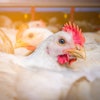
The production of broilers without the use of antibiotics is a rapidly growing trend, but cutting antibiotic use does have its drawbacks, said Matt Salois.
Salois discussed some of the drawbacks of poultry raised without antibiotics while speaking at the 2017 Chicken Marketing Summit on July 17. Salois was director of global scientific affairs and policy for Elanco at the time of the summit, but has since become the chief economist and Veterinary Economics Division director, American Veterinary Medial Association.
According to Salois, eliminating antibiotic use in broilers can lead to increased problems with wet litter, which in turn cause an increase in three health risks.
“None of these are good for animal welfare,” said Salois. “All of them are outcomes you want to avoid. Each of them have a higher risk of occurrence and severity in a recent antibiotics study, compared to conventional [poultry production].”
According to a study Salois was involved with, raising poultry without antibiotics increases the incidence of:
1. Ammonia burns to the cornea
Ammonia burns to the eyes, and specifically the corneas, are painful to chickens. The occurrence of such burns are 3.5 times greater in flocks raised without antibiotics, said Salois.
2. Severe foot lesions
The incidence of foot pad lesions are 1.4 times greater in flocks raised without antibiotics, he said. These lesions can lead to further bacterial infections.
3. Airsacculitis
Poultry raised without antibiotics risk contracting airsacculitis, which is a serious respiratory condition, and the risk becomes 1.5 times greater than conventionally raised broilers, said Salois. The incidence of airsacculitis leads to respiratory distress with neck swelling and difficulty breathing, which often leads to death, he said.
Animal welfare issue also a food waste issue
Salois pointed out that there is a significant amount of talk in the poultry industry concerning food waste, which he considers a serious issue. Usually, people think of food waste at the consumer level, but attention must also be paid to the waste at the animal production level.
“There is a tremendous amount of food waste with the loss of animals due to disease,” he said.
Comprehensive resource for antibiotic-free poultry production available
A collection of exclusive articles, blogs, infographics and videos on antibiotic-free poultry production, by trusted WATT Global Media editors and industry experts, equip poultry producers and marketers with information to help them make critical business decisions. Purchase your copy.


















